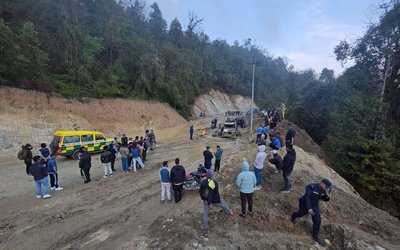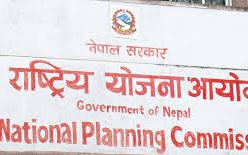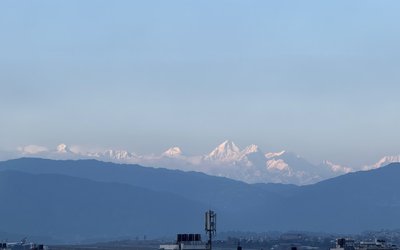The plan to implement the Dudh-Kosi storage dam hydropower project shelved for quite some time has again resurfaced. The NEA intends to implement this project exclusively for power generation in near future completely ignoring irrigation aspect. This decision would be a direct blow to our country’s ambition to attain in near future self-sufficiency in food grains production.
Nepal Electricity Authority would be committing grave blunder if it implemented the Dudh-Kosi storage dam hydropower project sidelining the recommendations of the UNDP/FAO study. The proposed storage dam project would completely rule out the possibility to use the potential of the Dudh-Kosi river to irrigate our Eastern Terai lands to bring down our growing dependency on import of food grains.
Worst of all that it would virtually become meaningless to implement the highly attractive Sun-Kosi (Kurule) multipurpose project to divert the combined flow of both Sun-Kosi and Dudh-Kosi rivers to irrigate our almost entire lands in Eastern Terai extending from Parsa district to Kosi and also to generate abundant cheap electricity by implementing just one single diversion barrage project.
UNDP/FAO Study
The necessity of the irrigation development on a large scale in Nepal had been keenly felt since the middle of 1960s. Bearing in mind such necessity of large scale irrigation development, the experts of the Food and Agriculture Organization and the Government of Nepal had carried out feasibility study. The plan to divert the Sun-Kosi River into the Kamla River has been presented in a feasibility report. The final feasibility report was submitted in October, 1972.
The feasibility report makes it perfectly clear that the people in Nepal are mostly dependant for their food supply and livelihood on a narrow belt of cultivated land in Terai. The potential to add new land for cultivation is very limited in Nepal. Thus, there is a need to raise agricultural productivity by increasing cropping intensity. The Sun-Kosi diversion could help to provide sufficient water round the year to increase the cropping intensity as well as per hectare yield, as a result, the agricultural production could be substantially increased.
Dudh-Kosi Water out of Reach
Implementation of the Dudh-Kosi High Dam Power Project would result in outright killing the potential of the Sun-Kosi river for utilization of the entire flow of the this river ( including Dudh-Kosi flow ) for power generation and also irrigating the vast area of Eastern Terai by building just one single barrage across the Sun-Kosi at Kurule.
The entire regulated flow of the Dudh- Kosi discharged after power generation by the proposed Dudh-Kosi project hydropower station would be directly dropped into the Kosi with the result that the Dudh-Kosi river water would be completely out of reach for irrigation in our country's Eastern Terai
Unlike the UNDP/FAO proposed Sun-Kosi diversion multipurpose project ( with barrage at Kurule), the proposed Dudh-Kosi High Dam project would be submerging vast area of hill valley, which would have serious environmental consequences for that region.
The Kurule Dam
The UNDP/FAO had provided Nepal technical and financial assistance to conduct the study of the Sun-Kosi dam project for the agricultural development in the Terai Plain. The UNDP/FAO study had identified Kurule , the confluence of Dudh-Kosi and the Sun-Kosi as the best site for a barrage to divert the entire flow of the Sun-Kosi into Kamla for irrigation in our Eastern Terai
The Government of India had also investigated the Sun-Kosi dam site in 1940s. At that time India was exploring the possibility of building the Sun-Kosi dam primarily for controlling the Kosi River floods. The Indian survey team had favoured Kurule dam site on the Sun-Kosi River because it appeared geologically sound and allowed to have a big storage reservoir that extended in Dudh-Kosi and Sun-Kosi valleys. In all subsequent studies that followed thereafter the location for the dam at Kurule has remained unchanged.
The Master Plan study of the Kosi River water resources was made in 1985 by Japan Government Agency team. The Sun-Kosi River diversion for irrigating lands in the Eastern Terai had been identified as one of the top priority projects in the Master Plan study. That study too had adopted the Kurule as the appropriate location for the dam across the Sun-Kosi River to divert it into the Kamla River.
Watering down the 1966 Revised Kosi Treaty
The 1954 Kosi Treaty was signed between Nepal and India . Realizing the great significance of the entire Sun-Kosi water for irrigation in our Eastern Terai, Nepal wanted to make it absolutely sure that India recognizes our country's right to entire flow of the Sun-Kosi. As a result, the Kosi Treaty was revised in 1966. India's recognization of our country's right to entire waters of the Sun-Kosi has been explicitly expressed in the revised treaty. The Article 4 ( i ) of the Treaty related with the water rights has been presented hereinafter:
"HMG shall have every right to withdraw for irrigation and for any other purpose in Nepal water from the Kosi river and from the Sun-Kosi river or within the Kosi basin from any other tributaries of the Kosi river as may be required from time to time. The Union ( it indicates India ) shall have the right to regulate all the balance of supplies in the Kosi river at the barrage site thus available from time to time and to generate power in the Eastern Canal."
After the implementation of the Dudh-Kosi High Dam Power Project the entire Dudh-Kosi river water would be out of reach for irrigation in our Eastern Terai. Thus we ourselves would be denying our country the right to use the entire of the Sun-Kosi, which has been explicitly expressed in the Revised 1966 Kosi Treaty.
A Great National Loss
Most countries are invariably found to be at loggerhead with their neighbouring countries to protect their right to water of their rivers and prepared even to wage a war to defend such rights. Perfect examples of such confrontation in our region are the dispute between India and Pakistan over the Upper Bari Canal drawing water from the Jungipur Barrage built across the Sutlez River. Similarly, other such example is the dispute between India and Bangladesh over the withdrawal of a limited flow of the Ganges into the Bhagirathi.
Much to our chagrin, despite a long standing agreement between Nepal and India establishing our country's absolute right to entire flow of the Sun-Kosi river, perhaps ignorantly, we ourselves are now preparing to curtail substantially the dry season irrigation potential of the Sun-Kosi by bulding the Dudh-Kosi storage dam hydropower project which would be discharging the entire regulated flow almost directly into the Kosi. As a result, the regulated flow of the Dudh-Kosi would be completely out of reach for irrigation in Eastern Terai. Unfortunately, our economists, planners, intelligentsia and social and political institutions dedicated to Nepal's progress are as yet seemed to be completely indifferent at such a great national loss.

Dr. A.B. Thapa
Thapa writes on water resources issue
- Dudh-Kosi Power Project And Kosi Treaty
- Sep 27, 2021
- Uttarakhand Glaciers And Recent Disaster: A Lesson To Our Country
- Mar 02, 2021
- Multipurpose Langtang After Melamchi: Inter-Basin Water Transfer
- Nov 04, 2020
- Large Storage Dams Projects Wary of Giving Away Children’s Inheritance
- Dec 22, 2019
- ECONOMIC AND ENVIRONMENTAL CATASTROPHE STORAGE DAM FAILURE
- Nov 17, 2019













